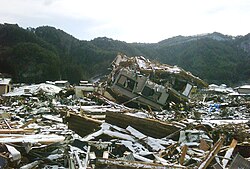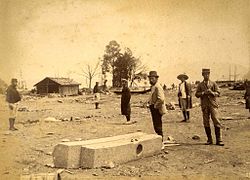Tsunami breakwaters in Kamaishi city and in Ofunato city before the 2011 tsunami
(c) Anawat Suppasri, Nobuo Shuto, Fumihiko Imamura, Shunichi Koshimura, Erick Mas, Ahmet Cevdet Yalciner, CC BY 2.0
Autor/Urheber:
Anawat Suppasri, Nobuo Shuto, Fumihiko Imamura, Shunichi Koshimura, Erick Mas, Ahmet Cevdet Yalciner: "Lessons Learned from the 2011 Great East Japan Tsunami: Performance of Tsunami Countermeasures, Coastal Buildings, and Tsunami Evacuation in Japan", Pure and Applied Geophysics, 170, 6-8, (2013), pp. 993–1018, DOI: https://doi.org/10.1007/s00024-012-0511-7, online published on 7 July 2012, here: p. 997, Figure 3 ("Tsunami breakwaters in Kamaishi city and in Ofunato city (before the 2011 tsunami)"), License: Creative Commons Attribution 2.0 Generic (CC BY 2.0). URL of the image file: https://media.springernature.com/original/springer-static/image/art%3A10.1007%2Fs00024-012-0511-7/MediaObjects/24_2012_511_Fig3_HTML.jpg.
Shortlink:
Quelle:
Größe:
746 x 260 Pixel (42559 Bytes)
Beschreibung:
Source: Anawat Suppasri, Nobuo Shuto, Fumihiko Imamura, Shunichi Koshimura, Erick Mas, Ahmet Cevdet Yalciner: "Lessons Learned from the 2011 Great East Japan Tsunami: Performance of Tsunami Countermeasures, Coastal Buildings, and Tsunami Evacuation in Japan", Pure and Applied Geophysics, 170, 6-8, (2013), pp. 993–1018, DOI: https://doi.org/10.1007/s00024-012-0511-7, online published on 7 July 2012, here: p. 997, Figure 3 ("Tsunami breakwaters in Kamaishi city and in Ofunato city (before the 2011 tsunami)"), License: Creative Commons Attribution 2.0 Generic (CC BY 2.0). URL of the image file: https://media.springernature.com/original/springer-static/image/art%3A10.1007%2Fs00024-012-0511-7/MediaObjects/24_2012_511_Fig3_HTML.jpg.
Caption as given in the above cited source: "Tsunami breakwaters in Kamaishi city and in Ofunato city (before the 2011 tsunami)"
Context as given in the above cited source: "Large-scale tsunami breakwaters are present along the Sanriku coast. They were constructed to protect cities from future tsunamis, because of the region’s long history of devastating tsunamis. The tsunami breakwaters were designed to resist tsunamis that are similar in strength to the 1896 Meiji Sanriku tsunami. Two well-known tsunami breakwaters are located in Kamaishi city and Ofunato city. In Kamaishi, the tsunami breakwaters were constructed at the entrance to the bay; they are 63 m deep and hold the Guinness world record for the deepest breakwaters (Fig. 3, left). Construction of the breakwaters was completed in 2009; they have a 300 m opening and are 670 and 990 m long (Kamaishi port office, 2011). The two tsunami breakwaters in Ofunato city were constructed after the city was struck by a large tsunami with long-period waves caused by resonance with the tsunami generated by the 1960 Chilean earthquake (Fig. 3, right). The two breakwaters are located at the bay entrance where the water is 38 m deep; they have a 200 m wide opening and are 290 and 250 m long (Kamaishi port office, 2011). Construction of the breakwaters was completed in 1967 and successfully protected the city from the Tokachi-oki tsunami in 1968."
Kommentar zur Lizenz:
Diese Datei ist unter der Creative-Commons-Lizenz „Namensnennung 2.0 generisch“ (US-amerikanisch) lizenziert.
Namensnennung: Anawat Suppasri, Nobuo Shuto, Fumihiko Imamura, Shunichi Koshimura, Erick Mas, Ahmet Cevdet Yalciner
- Dieses Werk darf von dir
- verbreitet werden – vervielfältigt, verbreitet und öffentlich zugänglich gemacht werden
- neu zusammengestellt werden – abgewandelt und bearbeitet werden
- Zu den folgenden Bedingungen:
- Namensnennung – Du musst angemessene Urheber- und Rechteangaben machen, einen Link zur Lizenz beifügen und angeben, ob Änderungen vorgenommen wurden. Diese Angaben dürfen in jeder angemessenen Art und Weise gemacht werden, allerdings nicht so, dass der Eindruck entsteht, der Lizenzgeber unterstütze gerade dich oder deine Nutzung besonders.
Lizenz:
Credit:
Anawat Suppasri, Nobuo Shuto, Fumihiko Imamura, Shunichi Koshimura, Erick Mas, Ahmet Cevdet Yalciner: "Lessons Learned from the 2011 Great East Japan Tsunami: Performance of Tsunami Countermeasures, Coastal Buildings, and Tsunami Evacuation in Japan", Pure and Applied Geophysics, 170, 6-8, (2013), pp. 993–1018, DOI: https://doi.org/10.1007/s00024-012-0511-7, online published on 7 July 2012, here: p. 997, Figure 3 ("Tsunami breakwaters in Kamaishi city and in Ofunato city (before the 2011 tsunami)"), License: Creative Commons Attribution 2.0 Generic (CC BY 2.0). URL of the image file: https://media.springernature.com/original/springer-static/image/art%3A10.1007%2Fs00024-012-0511-7/MediaObjects/24_2012_511_Fig3_HTML.jpg. See https://link.springer.com/article/10.1007%2Fs00024-012-0511-7 for Context and license
Relevante Bilder

(c) Anawat Suppasri, Nobuo Shuto, Fumihiko Imamura, Shunichi Koshimura, Erick Mas, Ahmet Cevdet Yalciner, CC BY 2.0

(c) Anawat Suppasri, Nobuo Shuto, Fumihiko Imamura, Shunichi Koshimura, Erick Mas, Ahmet Cevdet Yalciner, CC BY 2.0








(c) Anawat Suppasri, Nobuo Shuto, Fumihiko Imamura, Shunichi Koshimura, Erick Mas, Ahmet Cevdet Yalciner, CC BY 2.0

(c) ひでわく, CC BY 2.1 jp
















Relevante Artikel
KamaishiKamaishi ist eine Stadt in der Präfektur Iwate auf Honshū, der Hauptinsel von Japan. .. weiterlesen
ŌfunatoŌfunato ist eine Stadt in der Präfektur Iwate auf Honshū, der Hauptinsel von Japan. .. weiterlesen
